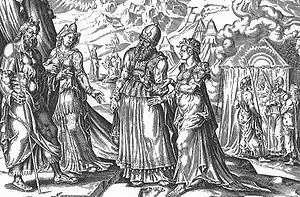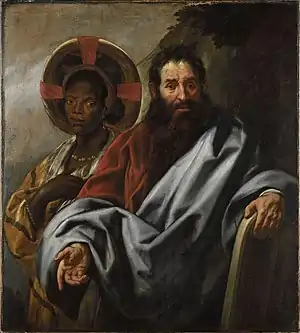Zipporah
Zipporah or Tzipora (/ˈzɪpərə, zɪˈpɔːrə/; Hebrew: צִפֹּרָה, Tsippōrāh, "bird")[lower-alpha 1] is mentioned in the Book of Exodus as the wife of Moses, and the daughter of Reuel/Jethro, the priest and prince of Midian.[2][3][4][5][6] In the Book of Chronicles, two of her grandsons are mentioned: Shebuel, son of Gershom, and Rehabiah, son of Eliezer (1 Chronicles 23:16-17).
Zipporah | |
|---|---|
 | |
| Known for | Wife of Moses |
| Spouse(s) | Moses |
| Children | Gershom Eliezer |
| Parent(s) | Jethro |
| Relatives | six sisters Aaron (brother-in-law) Miriam (sister-in-law) |
Biblical narrative

Background
In the Torah Zipporah was one of the seven daughters of Jethro, a Kenite shepherd who was a priest of Midian.[7] In Exodus 2:18 Jethro is also referred to as Reuel, and in the Book of Judges (Judges 4:11) as Hobab.[8] Hobab is also the name of Jethro's son in Numbers 10:29.
Moses marries Zipporah
While the Israelites/Hebrews were captives in Egypt, Moses killed an Egyptian who was striking a Hebrew, for which offense Pharaoh sought to kill Moses. Moses therefore fled from Egypt and arrived in Midian. One day while he sat by a well, Reuel's daughters came to water their father's flocks. Other shepherds arrived and drove the girls away so they could water their own flocks first. Moses defended the girls and watered their flocks. Upon their return home their father asked them, "How is it that you have come home so early today?" The girls answered, "An Egyptian rescued us from the shepherds; he even drew water for us and watered the flock." "Where is he then?" Reuel asked them. "Why did you leave the man? Invite him for supper to break bread." Reuel then gave Moses Zipporah as his wife (Exodus 2:11-21).
Incident at the Inn
After God commanded Moses to return to Egypt to free the Israelites, Moses took his wife and sons and started his journey. On the road, they stayed in an inn, where God came to kill Moses. Zipporah quickly circumcised her son with a sharp stone and touched Moses' feet with the foreskin, saying "Surely you are a husband of blood to me!" God then left Moses alone (Exodus 4:24-26). The details of the passage are unclear and subject to debate.
The Exodus

After Moses succeeded in taking the Israelites out of Egypt, and won a battle against Amalek, Reuel came to the Hebrew camp in the wilderness of Sinai, bringing with him Zipporah and their two sons, Gershom and Eliezer. The Bible does not say when Zipporah and her sons rejoined Reuel/Jethro, only that after he heard of what God did for the Israelites, he brought Moses' family to him. The most common translation is that Moses sent her away, but another grammatically permissible translation is that she sent things or persons, perhaps the announcement of the victory over Amalek.[9] The word that makes this difficult is shelucheiha, the sendings [away] of her (Ex. 18:2).
Wife of Moses
Moses' wife is referred to as a Cushite in Numbers 12. Interpretations differ on whether this Cushite wife was one and the same as Zipporah, or another woman, and whether he was married to them simultaneously (which would make him a polygamist) or successively.[10][11][12] In the story Aaron and Miriam harshly criticize Moses' marriage to a Cushite or Kushite woman after he returned to Egypt to set the children of Israel free. This displeases God, who punishes Miriam with leprosy. Cushites were of the ancestry of either Kush (a.k.a. Nubia) in northeast Africa, or Arabians. The sons of Ham, mentioned within the Book of Genesis, have been identified with nations in Africa (Ethiopia, Egypt, Libya), the Levant (Canaan), and Arabia. The Midianites themselves were later on depicted at times in non-Biblical sources as dark-skinned and called Kushim, a Hebrew word used for dark-skinned Africans.[13][14] One interpretation is that the wife is Zipporah and that she was referred to as a Cushite though she was a Midianite, because of her beauty.[15]
The Samaritan Pentateuch text refers to Moses' wife Zipporah as "Kaashet" (which translates to "the beautiful woman"), rather than "Cushit" ("black woman" or "Cushite woman"). Therefore, the Samaritan sages came to the understanding that Moses married only one wife, and once he became absolutely devoted to his prophetic mission he never got married again.[16]
"Cushite woman" becomes Aethiopissa in the Latin Vulgate Bible version (4th century). Alonso de Sandoval, 17th century Jesuit, reasoned that Zipporah and the Cushite woman was the same person, and that she was black. He puts her in a group of what he calls "notable and sainted Ethiopians".[17]:248, 253–254
In Druze religion
In the Druze religion, Zipporah's father Jethro is revered as the spiritual founder, chief prophet, and ancestor of all Druze.[2][3][5][6][18] Moses was allowed to wed Zipporah after helping save his daughters and their flock from competing herdsmen.[19] It has been expressed by prominent Druze such as Amal Nasser el-Din[20] and Salman Tarif, who was a prominent Druze shaykh, that this makes the Druze related to the Jews through marriage.[21] This view has been used to represent an element of the special relationship between Israeli Jews and Druze.[22]
In fiction
Zipporah is often included in Exodus-related drama. Examples include the films The Ten Commandments (1956),[23] The Prince of Egypt (1998)[24] and Exodus: Gods and Kings (2014).[25]
She is the main character in Marek Halter's novel Zipporah, Wife of Moses (2005).[26]
See also
- Sephora, cosmetics store named after Zipporah
- Tharbis - according to Josephus, a Cushite princess who married Moses prior to his marriage to Zipporah as told in the Book of Exodus
- Tziporah (Tzipi) Malka Livni - Israeli politician
- Tzipora Obziler (born 1973), Israeli tennis player
Notes
- Greek: Σεπφώρα, Sepphōra; Arabic: صفورة, Ṣaffūrah
References
- Harwood, Edith (1907). Notable pictures in Rome. J.M. Dent. p. 6.
- Corduan, Winfried (2013). Neighboring Faiths: A Christian Introduction to World Religions. p. 107. ISBN 978-0-8308-7197-1.
- Mackey, Sandra (2009). Mirror of the Arab World: Lebanon in Conflict. p. 28. ISBN 978-0-3933-3374-9.
- Lev, David (25 October 2010). "MK Kara: Druze are Descended from Jews". Israel National News. Arutz Sheva. Retrieved 13 April 2011.
- Blumberg, Arnold (1985). Zion Before Zionism: 1838-1880. Syracuse, NY: Syracuse University Press. p. 201. ISBN 0-8156-2336-4.
- Rosenfeld, Judy (1952). Ticket to Israel: An Informative Guide. p. 290.
- Harris, Stephen L., Understanding the Bible. Palo Alto: Mayfield. 1985.
- "Judges 4 / Hebrew - English Bible / Mechon-Mamre". mechon-mamre.org. Retrieved 2014-04-05.
- See e.g. Ibn Ezra on Exodus 18:2 - ור׳ ישועה אמר: ששלוחיה הוא דורון ומנחה, כמו: שלוחים לבתו (מלכים א ט׳:ט״ז). והטעם: אחר שיגרה דרונה וזה קרוב אלי.
- Brent MacDonald, Who was Moses' wife? A Midianite, a Cushite, or both?, 2015 at NotJustAnotherBook.com, accessed 13 August 2018
- Dr. Elad Filler, Moses and the Kushite Woman: Classic Interpretations and Philo's Allegory, at TheTorah.com: A Historical and Contextual Approach, accessed 13 August 2018
- Shlomo Skinner, The Mystery of the Cushite Woman, at Thinking Torah, accessed 13 August 2018
- David M. Goldenberg. The curse of Ham: race and slavery in early Judaism, Christianity, and Islam, chapter 8. p. 124.
- Israël Shahak. Jewish history, Jewish religion: the weight of three thousand years. p. 25
- Filler, Elad. "Moses and the Kushite Woman: Classic Interpretations and Philo's Allegory". TheTorah.com. Retrieved 10 May 2019.
- Tsedaka, Benyamim, and Sharon Sullivan, eds. The Israelite Samaritan Version of the Torah: First English Translation Compared with the Masoretic Version. Wm. B. Eerdmans Publishing, 2013. ISBN 978-0802865199
- McGrath, Elizabeth (2007). "Jacob Jordaens and Moses's Ethiopian Wife". Journal of the Warburg and Courtauld Institutes. 70: 247–285. ISSN 0075-4390.
- Lev, David (25 October 2010). "MK Kara: Druze are Descended from Jews". Israel National News. Arutz Sheva. Retrieved 23 March 2015.
- Nettler (1998). Muslim-Jewish Encounters. p. 139. ISBN 1-1344-0854-4.
- Mordechai Nisan (1 Jan 2002). Minorities in the Middle East: A History of Struggle and Self-Expression, 2d ed. McFarland. p. 282. ISBN 9780786451333.
- Eugene L. Rogan; Avi Shlaim (2001). The War for Palestine: Rewriting the History of 1948 (illustrated, reprint ed.). Cambridge University Press. p. 72. ISBN 9780521794763.
- Alex Weingrod (1 Jan 1985). Studies in Israeli Ethnicity: After the Ingathering. Taylor & Francis. p. 273. ISBN 9782881240072.
- Thomas, Bob (12 January 2007). "Yvonne De Carlo, 84; Said Her 'Munsters' Role Made Her Hot". Retrieved 7 March 2018 – via www.washingtonpost.com.
- Laird, Paul R. (2014). The Musical Theater of Stephen Schwartz: From Godspell to Wicked and Beyond. Scarecrow Press. p. 246. ISBN 9780810891920. Retrieved 7 September 2019.
- Tollerton, David (2016). Biblical Reception, 4: A New Hollywood Moses: On the Spectacle and Reception of Exodus: Gods and Kings. Bloomsbury Publishing. p. 41. ISBN 9780567672339. Retrieved 7 September 2019.
- "Zipporah, Wife of Moses". www.publishersweekly.com. Publishers Weekly. Retrieved 10 September 2019.
Further reading
- Pardes, Ilana (1992). "Zipporah and the Struggle for Deliverance" in Countertraditions in the Bible: A Feminist Approach. Cambridge: Harvard University Press. ISBN 9780674175426
- Piper, John (September 2007). "Did Moses Marry a Black Woman?". 9Marks.
- Moses and the Kushite Woman: Classic Interpretations and Philo’s Allegory, thetorah.com
